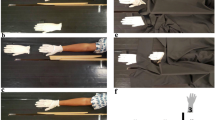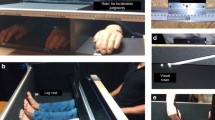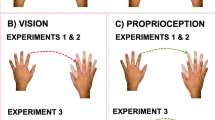Abstract
We combined a few methods to effectively create the illusion of embodiment and sense of body motion in the framework of the rubber hand illusion. In our experiments, active hand movements and self-stimulation were employed instead of classical passive tactile stimuli applied to still hands. The combination of these conditions effectively created the illusion. Furthermore, we collectively tested the effects of visual stimuli that were accompanied with tactile sensations. Specifically, we observed that when an object associated with tactile sensations was moving around the fake hand, the illusion tended to be more intensively induced than when an object that was unlikely to be associated with tactile sensations was placed still near the fake hand.
Access provided by Autonomous University of Puebla. Download conference paper PDF
Similar content being viewed by others
Keywords
These keywords were added by machine and not by the authors. This process is experimental and the keywords may be updated as the learning algorithm improves.
1 Introduction
The rubber hand illusion (RHI) is a bodily illusion, in which a visible fake rubber hand is perceived as an invisible actual hand when a set of tactile stimuli is continuously provided to the fake and actual hands in a spatially-congruent and temporarily-synchronous manner. Since Botvinick and Cohen [2] discovered that the visual and tactile stimulation effectively induce the illusory ownership over the fake rubber hand, several studies have often used the RHI paradigm to assess bodily illusions. The RHI can be also induced when the movement of actual body corresponded with the behavior of the fake body even if the tactile stimuli were not presented to the body; recent studies reported that the combination of active hand movement and self-stimulation could induce stronger RHI [1, 3, 6, 7]. Furthermore, congruency among multiple sensory cues is regarded important [4], indicating that spatiotemporal discrepancies between the fake and actual hands should be minimized to create the embodiment of the fake hand.
Recently, Ferri et al. reported that their participants could experience RHI by visual stimuli associated with tactile sensations [5]. They demonstrated that an object (a human hand of a third person) approaching the fake hand caused the illusory experience without contact between the object and fake hand. Based on the study by Ferri et al., a question is naturally raised; what kind of visual attention to the object near the fake hand is effective for causing the illusion?
In this paper, we experimentally investigated the two questions. The first question is whether the combination of the previously reported conditions, which were separately tested in earlier studies, effectively evokes the illusion. To test this question, based on the studies on the effects of active hand movements and self-stimulation [1, 3, 7], the fake hand was moved in synch with the actual hand of the participants. To ensure that the tactile stimuli were fed back according to the active hand movements and the active-touch, the participants tapped or rubbed a desktop. The second question is what kind of visuotactile attention to nearby objects is effective to induce the illusion. To test the effects of the visuotactile attention on the illusion, the participants were presented two types of objects under different motion conditions. One of the objects was associated with positive or pleasant tactile feelings, and the other was associated with neutral tactile feelings. Additionally, the effects of two types of motion conditions, namely moving and still conditions were tested. In the former condition, the object was moved in the vicinity of the fake hand without actual contact. We expected that the moving condition would more strongly induce tactile feelings than the still condition would. In this manner, we aimed to identify the condition that effectively led to the illusion.
2 Experiment
2.1 General Setup: RHI with Active Hand Motion and Tactile Feedback
The experimental setup comprised a rubber hand, a hide-box, a pair of sliders and linear guide for measuring the degree of proprioceptive drift (PD), and an acrylic rod and cloth as shown in Figs. 1 and 2. The hide-box and cloth hid the participant’s right shoulder to the hand. Participants could move the rubber hand simultaneously with their hands by controlling the acrylic rod fixed to the rubber hand.
2.2 Experimental Conditions
We prepared 6 experimental conditions as listed in Table 1. In Condition 1, the control condition, the rubber hand was disconnected from the acrylic rod, such that the rubber hand did not move with the hand motions of the participant. In this condition, due to the incongruence between the rubber and actual right hands, the illusion was less likely to occur. This condition was used to check if the participants experienced the RHI in the other conditions. In Condition 2, a normal condition, no objects around the rubber hand were used. Condition 2 was used as a normal (classical) condition to examine the influence of attention on the visual stimulation presented near the rubber hand on the RHI. In Condition 3 and 4, we used a paint brush as a positive tactile stimulation. In Condition 5 and 6, we used an eraser as a neutral tactile stimulation that may not be associated with tactile stimuli. In Condition 4 and 6, an experimenter moved each object around the rubber hand. In Condition 3 and 5, each object was placed at a distance of about 5 cm from the rubber hand. In Conditions 2–6, participants moved the rubber hand under the self-moving and active-touch condition. Each of these conditions was tested in a randomized order in a single set. In total, three sets (i.e., 18 trials) were performed for each participant. Regarding the data analysis, we considered that the experimental data in the first set is influenced by the order of tested conditions because the participants have never tried the condition. Hence, the experimental data in the first set were not analyzed in the present study.
2.3 Tasks
Before the experiment, participants wore rubber gloves in both hands, to get used to wearing the rubber gloves. They also practiced moving the rubber hand with the acrylic rod in both hands as shown in Fig. 1. During the experiment, the conditions listed in Table 1 were implemented randomly while participants tapped or rubbed their hand on the desk for a minute. Participants were told to keep tapping or rubbing the desk whereas they could move slowly, to ensure that they were not tired out during the trial. They were also asked to gaze at the fake hand during the task.
2.4 Participants
Five university students (four men and one woman, all right-handed, mean age = 24.6 years) voluntarily participated in the experiment with informed consent. All of them were unaware of the objectives of the study.
2.5 Questionnaire and Measurement of Proprioceptive Drift
We measured the strength of the RHI by assessing the dgree of PD and through a questionnaire; however, we note that PD is not always proportional to the strength of the RHI [8]. After each trial, the participants answered eight types of questionnaire items that were presented in a randomized order. Each question was answered using a 7-point scale (1: I disagree with the statement to 7: I agree with the statement). The employed questionnaire items are listed in Table 2, which were adapted from the original RHI questionnaire [2]. Thus far, these questionnaire items have been extensively used for the studies on rubber hand illusion. In our RHI questionnaire, the first and second items were related to the RHI (i.e., illusion items): the embodiment of the rubber hand, i.e., the experience that the viewed rubber hand was felt as if it were the one’s own hand (Q1) and the sense of agency (Q2). The other items which were irrelevant to the RHI (i.e., control items) were prepared to investigate the suggestibility. As for the control items, Q8 was newly added to investigate the sense of illusory touch with the object which should not be induced in our experiment; the other control items were readapted from the classical questionnaire items [2].
Before and after each trial, we tested the degree of PD of the right hand. Participants were instructed to close their eyes and point to the position of their right forefinger with the slider, using their left hand, within 3 seconds, to avoid weakening of the strength of the RHI. At the beginning of each measurement, the slider was located in front of the left hand as an initial position. The degree of the illusion of proprioception was determined as the difference between the position of the slider before and after the trial.
3 Experimental Results
Figures 3 and 4 present the findings related to the responses to Q1 and Q2, and the degree of PD for each stimulus condition. These results are the average of the second and third trials. One-way ANOVAs indicated significant differences in the ratings among the six types of stimulus conditions for the responses to Q1 (\(p < 0.01\)) and Q2 (\(p < 0.10\)). A post-hoc comparison between each pair of stimulus conditions revealed significant differences between condition 1 (control) and the others, at \(p < 0.05\), in terms of responses to both items, Q1 and Q2. There were no statistically significant differences among Conditions 2–6. These results indicated that, as compared to the control condition, all other stimulus conditions were effective in inducing the illusion.
However, there were no significant differences among any of the conditions in terms of the degree of PD. This may be because one minute, which was the duration of each trial, had been insufficiently long for causing the drift of proprioception. As mentioned before, PD is not always proportional to the strength of the RHI [8]. Therefor, we could not report any conclusive interpretations related to the degree of PD.
In order to test the suggestibility of the participants for the questionnaire, we compared the ratings assigned to Q1 or Q2 with the mean scores among Q3–Q8 for each stimulus condition with t-tests with Bonferroni correction factor of 2. As a result, for the most stimulus conditions, the scores for Q1 were significantly larger than the mean scores across Q3–Q8 at the significance level of \(p < 0.05\), except for Condition 1 and 2. The scores for Q2 were not significantly different from the mean scores across Q3–Q8 for all the stimulus conditions.
4 Discussion
Comparison of the questionnaire responses for normal and control conditions revealed the involvement of active hand movements and self-stimulation in causing the illusion, which is consistent with the findings of previous studies [1, 3, 7]. Additionally when visual attention to objects was added to the normal condition (conditions 3–6), the resultant illusion was stronger than that observed in the control condition.
Although it was not statistically supported, the brush, which was supposed to be linked to positive tactile sensations, tended to more effectively cause the illusion than did the eraser, which was linked to neutral tactile sensations. Furthermore, moving objects tended to be more effective than were still objects. These trends indicate that, as visual attention is more closely associated with tactile sensations, the resultant illusion is stronger. Based on this, we speculate that when an object near the fake hand is linked to tactile sensations, and is moved to further evoke sensations, the illusion is induced effectively. The paint brush and stroking motion in the air is one of the possible combinations of objects and related motions. Nonetheless, we did not find conclusive evidence for the effect of such objects and motions, because there were no significant differences between the conditions with and without such objects. In our experiments, the effect of visual attention might have been hidden by the strong effects of active hand motion and active-touch, especially because the normal condition was sufficient for inducing the illusion.
5 Conclusion
To identify the conditions necessary for effectively evoking the RHI, we performed a set of experiments combining a few approaches including active hand motions, self-stimulation, and objects to manipulate visuotactile attention. As we expected, these approaches collectively caused an intensive illusion as compared with that observed in the control condition. One of our main interests was in the effect of visual attention to the object associated with tactile sensations. Although it was not statistically valid, the stronger illusion was observed with these objects than was without the objects. As a trend, the object associated with tactile sensations was more effective in inducing the illusion, than was the object less associated with the same. Furthermore, a moving object, which was more stimulating than a still object, tended to lead to an intensive illusion. Further investigation of the role of visuotactile attention would help us identify the conditions that cause a more intensive RHI.
References
Arata, J., Hattori, M., Ichikawa, S., Sakaguchi, M.: Robotically enhanced rubber hand illusion. IEEE Trans. Haptics 7(4), 526–532 (2014)
Botvinick, M., Cohen, J.: Rubber hands ‘feel’ touch that eyes see. Nature 391, 756 (1998)
Dummer, T., Picot-Annand, A., Neal, T., Moore, C.: Movement and the rubber hand illusion. Perception 38, 271–280 (2009)
Ehrsson, H., Holmes, N., Passingham, R.: Touching a rubber hand: Feeling of body ownership is associated with activity in multisensory brain areas. J. Neurosci. 25(45), 10564–10573 (2005)
Ferri, F., Chiarelli, A., Merla, A., Gallese, V., Costantini, M.: The body beyond the body: Expectation of a sensory event is enough to induce ownership over a fake hand. Proc. Royal Soci. B 280(1765), 1499–1506 (2013). doi:10.1098/rspb.2013.1140
Hara, M., Rognini, G., Evans, N., Blanke, O., Yamamoto, A., Bleuler, H., Higuchi, T.: A novel approach to the manipulation of body-parts ownership using a bilateral master-slave system. In: Proceedings of IEEE/RSJ International Conference on Intelligent Robots and Systems, pp. 4664–4669 (2011)
Hara, M., Pozeg, P., Rognini, G., Higuchi, T., Fukuhara, K., Yamamoto, A., Higuchi, T., Blanke, O., Salomon, R.: Voluntary self-touch increases body ownership. frontiers in Psychology (2015). doi:10.3389/fpsyg.2015.01509
Rohde, M., Luca, M., Ernst, M.: The rubber hand illusion: Feeling ofownership and proprioceptive drift do not go hand in hand. PLoS ONE 6(6), e21659 (2011). doi:10.1371/journal.pone.0021659
Author information
Authors and Affiliations
Corresponding author
Editor information
Editors and Affiliations
Rights and permissions
Copyright information
© 2016 Springer International Publishing Switzerland
About this paper
Cite this paper
Itoh, K., Okamoto, S., Hara, M., Yamada, Y. (2016). An Attempt to Induce a Strong Rubber Hand Illusion Under Active-Hand Movement with Tactile Feedback and Visuotactile Stimulus. In: Bello, F., Kajimoto, H., Visell, Y. (eds) Haptics: Perception, Devices, Control, and Applications. EuroHaptics 2016. Lecture Notes in Computer Science(), vol 9775. Springer, Cham. https://doi.org/10.1007/978-3-319-42324-1_34
Download citation
DOI: https://doi.org/10.1007/978-3-319-42324-1_34
Published:
Publisher Name: Springer, Cham
Print ISBN: 978-3-319-42323-4
Online ISBN: 978-3-319-42324-1
eBook Packages: Computer ScienceComputer Science (R0)








